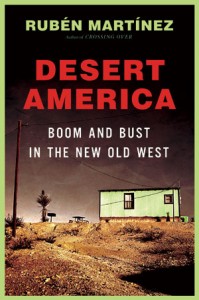Washington’s planned border barriers are running into cowboy resistance.
Los Angeles Times, October 17, 2007
I stood on the cottonwood-lined banks of the San Pedro River in Arizona recently and watched it flow freely under a “water gap” fence — two strands of barbed wire and two of wound cable. Those four strands, which mark the line between Mexico and the United States of America at the edge of the San Pedro Riparian National Conservation Area, are a modest boundary to be sure, as most of the border has been since 1848.
Soon, this border will get a much more powerful and disturbing representation. If the Department of Homeland Security and the Army Corps of Engineers have their way, a “vehicle barrier” made of railroad ties will cut across the river (although it will have to be removed each year before the monsoon floods, which would easily whisk it away). There are plans for permanent vehicle barriers just beyond the riverbed — steel posts sunk into 3 feet of concrete. And for “pedestrian fencing” made of double rows of concrete-filled 14- to 17-foot-high bollards. And for the “Sandia”-style variant, which uses panels of tight steel mesh. There will be a new “all-weather” road, lighting and electronic surveillance towers.
Faraway Washington has forgotten just how much cowboys can’t stand fences. And in this case, there are lots of cowboys: artists, students, activists, even politicians.
My guides of the San Pedro, for instance, were Greta Anderson, a Tucson-based environmental activist, and the accomplished painter Peter Young, a longtime Bisbee resident. The barbed wire is bad enough, said the artist, but this new fence would be “an atrocious scar upon the landscape.” The environmentalist spoke of jaguars and ocelots, of debris buildups and erosion and the possibility of the river itself “migrating.”
The San Pedro River, which runs atypically from south to north, will be virtually dammed as far as most people and many animals are concerned. Human migrants will be pushed from the river valley to torturous trails that cross the 9,000-foot-high peaks of the Huachuca Mountains; it is nearly certain the human death toll will begin to rise in the area.
This will happen because the Department of Homeland Security says so. The Secure Fence Act of 2006 mandates 700 miles of barriers, easily the most ambitious and controversial infrastructure project in border history. And although the department does indeed have the power to say so — including the authority to waive National Environmental Policy Act rules in the name of national security — resistance to the “wall” is proving to be a political obstruction Beltway politicos and Homeland Security functionaries hadn’t counted on.
It’s a new political convergence in the borderlands: environmentalists, social justice advocates and a cohort of new border activists who are apparently driven less by ideology than a simple Western love of open vistas — and plain common sense.
This loose coalition bridges a long-standing political gap.
Historically, some who called themselves environmentalists were more likely to complain about litter on the migrant trail than migrant deaths, or say that population control was preferable to immigration reform. In the borderlands, the sheer dimensions of the human tragedy make such thinking morally reprehensible.
But the farther environmentalists get from the border, it seems, the less they understand how the “natural” and “human” realms intersect here. No mainstream national environmental organization, for example, lobbied in favor of immigration reform during last year’s debate. If they had, the outcome of the votes on both reform and the Secure Fence Act might have been different.
The bulldozers were already within sight of the San Pedro River last week when a federal judge stayed further construction in response to a joint appeal from Defenders of Wildlife and the Sierra Club, which argued that “immediate and irreparable harm” would come to the river and its ecosystem.
In Texas, meanwhile, several Lower Rio Grande communities also are threatening lawsuits against the Homeland Security Department. Brownsville Mayor Pat Ahumada said his city will “instruct DHS to stop the building of the wall.” Some local officials have stalled construction by blocking the department’s access to the border. (The federal government has a 60-foot right of way but must often cross private or local public property to get to it.)
At the University of Texas, Brownsville students marched against a proposed barrier that would literally cut off access to part of its campus.

